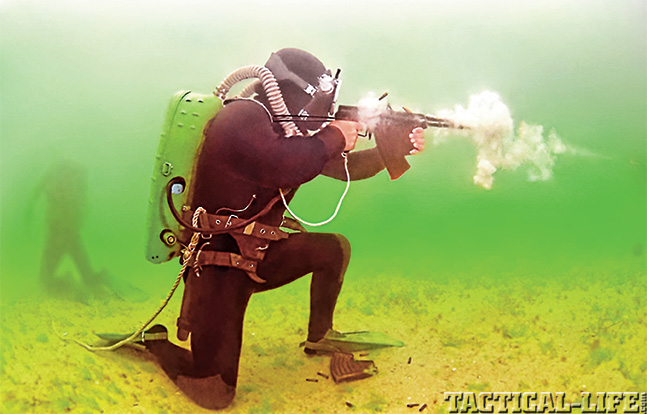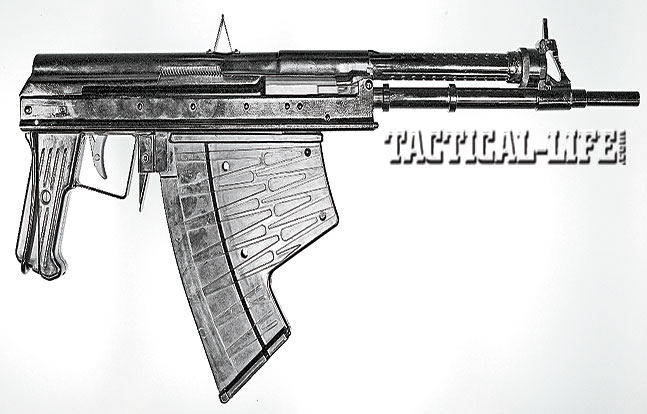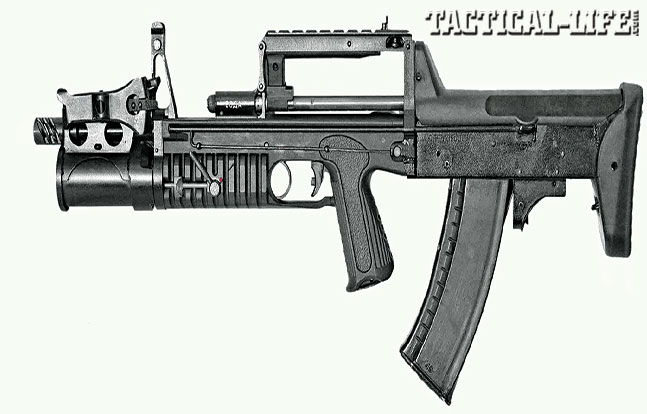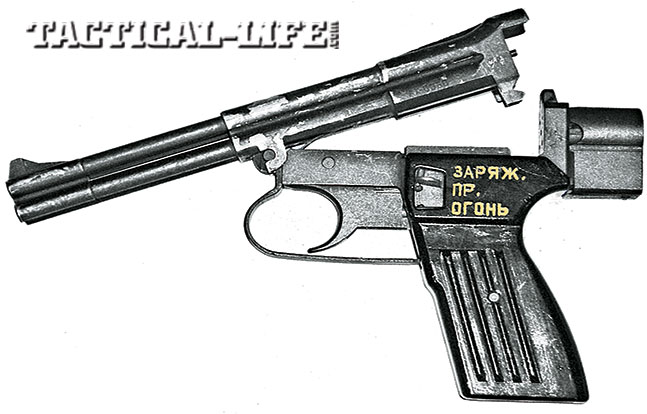The Soviet Navy first experimented with the use of combat divers during the Great Patriotic War of 1941-45. A small unit that operated in the Baltic Sea gained noticeable success during many shore operations, but it was disbanded soon after the defeat of Germany. It took the Soviet Navy’s leadership almost 10 more years to recognize the value of combat divers for naval operations as both offensive and defensive forces as well as for use in various reconnaissance missions.
The defensive role against NATO combat divers was especially important, as many NATO countries (such as Italy) had perfected their frogmen operations against enemy vessels and on-shore facilities to a high degree. Therefore, during the mid-1950s, the Soviet Navy instituted what became known as PDSS (Protivodiversionnye Sily I Sredstva), or counter-diversion forces and equipment. In an incident that likely played a key role in the Soviet’s decision to develop combat diving forces, the Soviet battleship Novorossiysk (formerly the Italian battleship Giulio Cesare, which was acquired by the Soviet Navy after WWII) was rumored to have been sunk by a bomb planted by Italian divers in 1955.
The new force consisted of a few highly trained combat divers and support teams. The equipment included many items, from specially designed scuba gear and high explosives to special submarines. It also included individual weapons. The earliest underwater personal weapons were usually knives or single-shot spear guns, but these were hardly adequate for use as combat weapons. Therefore, in about 1967, the Soviet Navy issued a requirement for a multi-shot underwater weapon that could be used against enemy combat divers. The challenge was taken by a small team of designers, led by Dmitry Shiryaev, working at TsNII Tochmash, which was (and still is) responsible for most special small-arms development in Russia.
Advertisement — Continue Reading Below
Submersible Pistols
The earliest experimental underwater weapon developed by Shiryaev was known as B-VI-307. It was a four-barreled, break-open pistol that fired needle-like 7.62mm rocket-assisted projectiles. After much experimentation it was perfected to the point of small-batch production for troop trials. However, certain personal issues between Shiryaev and management resulted in the abandonment of his work on rocket-assisted projectiles in favor of simple needle-like bullets of 4.5mm caliber that could be launched from specially designed rimmed cases. Four of these cases were loaded into the four-barreled, break-open pistol based on Shiryaev’s prototype using a spring clip that could be fired at ranges of up to 20 meters, depending on the depth. These projectiles were stabilized in water using a cavitation bubble, which was generated around the forward part of the bullet due to its specially designed nose shape. When fired above the water, those needle-like bullets had no stabilization at all and tumbled in the air, therefore defying any accuracy. However, they still maintained some wounding potential at point-blank ranges. This weapon and its ammunition were officially (and secretly) adopted by the Soviet Navy around 1972 as the SPP-1 pistol and the 4.5x40R SPS cartridge.
The SPP-1 pistol was of simple break-open design with a cluster of four smooth-bore barrels and a double-action-only (DAO) trigger. SPS cartridges consisted of a rimmed 40mm brass case loaded with a lacquered, 115mm-long steel bullet. Bullet weight is 204 grains, and muzzle velocity above the water is about 820 fps. Effective range when submerged depends on the depth, and varies between roughly 17 meters at 5 meters of depth down to 10 meters at 20 meters of depth (55 feet at 16 feet of depth; 33 feet at 65 feet of depth). To achieve stabilization in the water, which is several hundred times denser than the air, the nose of the bullet is shaped as a truncated cone. A small flat on the nose creates a cavitation bubble, which encloses the front part of the projectile, decreasing friction and providing dynamic stabilization. The assembled cartridge is sealed against the water with a special composition around the case neck and a lacquer coating around the primer.
Advertisement — Continue Reading Below
To speed up the loading process, cartridges are inserted into flat steel clips, similar in concept to the “full-moon” clips used in some revolvers. Loaded clips are carried in special plastic containers on the belt of the diver, one four-round clip per container. Once all four cartridges are fired, they are automatically ejected at once (along with the clip) as the barrel cluster is opened. Controls of the pistol are relatively simple, and include a DAO trigger and a single safety/release lever on the left, which also acts as a barrel latch when pushed up from its “safe” position.
Dive-Ready Rifles
The SPP-1 pistol was simple, relatively inexpensive and more or less on par with Western equivalents, such as the German HK P11 underwater pistol. It was effective against human targets in its intended role, but certain PDSS scenarios included attacks of superior forces of NATO divers while using special transportation equipment. As a result, in the early 1970s, the Soviet Navy issued requirements for more powerful, fully automatic underwater weapons, including individual rifles and crew-served machine guns. The machine guns were intended to be used on stationary positions to defend naval bases from underwater attacks, and also to be mounted on special underwater crafts. For some yet undisclosed reason underwater machine gun requirements were soon abandoned, but the concept of the underwater automatic rifle soldiered on to become the APS underwater rifle.
Advertisement — Continue Reading Below
It was developed at the same TsNII Tochmash organization by a team led by Vladimir Simonov, and officially entered the service with the Soviet Navy around 1975. To achieve a slightly longer range and better lethality, it used needle-type steel bullets of 5.66mm caliber that weighed 300 grains each. Muzzle velocity above the water was 1,150 fps. These bullets were loaded into standard 5.45×39 M74 lacquered steel cases, with added sealing at the case mouth and around the primer. The new cartridge was capable of penetrating the hull of a light underwater craft, punching through the compressed air tanks and inflicting noticeable damage to almost any dangerous live beings found below the sea that might prove to be a threat to the divers.
To improve effectiveness during low-light underwater conditions, special tracer rounds were developed. Its trace is visible in the water even during most dark conditions.
The rifle itself is of simple, basic design, made mostly from steel stampings with protective coatings. It is a gas-operated weapon with rotary bolt locking, firing from an open bolt. The gas system features a patented self-adjusting gas valve, which allows the gun to be fired both underwater and in atmosphere. The simple trigger unit allows for single-shots and full-automatic fire through the three-position safety/fire mode selector located on the left side, above the pistol grip. The rate of fire under water, as well as the effective range, depends on the actual depth.
Advertisement — Continue Reading Below
The APS’ sights are crude: a non-adjustable open notch rear and post front. The retractable buttstock is made from steel wire. The most complicated thing in the whole design is the feed system, which includes several parts to avoid double and even triple feed with the extremely long projectiles. Unusually deep (front to back) magazines are made from polymer and hold 26 rounds. This truly unique weapon is still in service with the Russian Navy, but it has its shortcomings.
First, while it is quite effective below the water, its effectiveness above sea level is very limited due to the same problem as with SPP-1 pistol—long, non-rotating bullets tumbling in the air. Second, the service life of the gun, when fired in the air, is severely limited and is estimated at just 2,000 rounds. Therefore, while PDSS units are more or less satisfied with the APS rifle, recon and assault elements of the Russian Navy Special Forces desired a weapon that would operate effectively both under the water and above it. First experiments on “dual medium” or “amphibious” automatic rifles were conducted during the early 2000s at Russia’s Tula State University. An experimental ASM-DT weapon developed there had a 5.45mm barrel with shallow rifling grooves that would accept standard 5.45×39 M74 ammunition for “above the sea” use and long-bulleted “underwater” projectiles of a slightly reduced caliber. The modified magazine housing had a movable magazine catch that could be positioned forward to reduce the magazine opening’s size to fit standard AK-74 magazines, or moved rearward to accept long, specially designed “underwater” magazines. Due to the complexity of the design, it was never put into production.
True Amphibian
Advertisement — Continue Reading Below
The true “amphibious” solution was found around 2004, when a group of Russian engineers and researchers from the KBP design bureau in Tula developed an underwater cartridge compatible in its dimensions to standard 5.45×39 M1974 ammunition. This new cartridge is known as 5.45×39 PSP, and it is externally similar to standard 5.45×39 ammunition except that it has a different bullet shape. Internally it differs in having a relatively long, conical bullet that has a specially calculated shape and protrudes back into the cartridge case all the way to the bottom, with overall bullet length being about 53.3mm, compared to an overall cartridge length of 57mm. The bullet is fitted with a polymer driving band, which is located at the mouth at the cartridge when loaded. There are two types of PSP ammunition. First is the 5.45 PSP (combat ammunition) with a hardened steel AP projectile weighing 247 grains and a muzzle velocity in air of about 1,000 fps. Second is 5.45 PSP-U (practice/training ammunition) with a bronze projectile weighting 124 grains, with muzzle velocity in air about 1,400 fps. Effective range with PSP ammunition varies from 25 meters at 5 meters of depth (82 feet at 16 feet of depth) to 18 meters at 20 meters of depth (60 feet at 65 feet of depth); effective range of the PSP-U training ammunition when below the water is about two times shorter. Because the barrel of the weapon is rifled, PSP-type projectiles retain some stabilization in the air and could be used for “above sea” fighting in emergency situations.
Having settled on new ammunition, designers at KBP commenced work on the new weapon, now well suitable for both surface and underwater combat. This new rifle was designated as ADS (Avtomat Dual-Medium Special). They used the A-91M bullpup assault rifle as a starting point, retaining its bullpup layout, gas-operated action with rotary bolt locking and forward ejection through the short tube running above and to the right of the barrel. Some parts of the weapon were necessarily redesigned, and some materials were revised to work reliably when submerged in salt water. The gas system was modified with the addition of the manual environment selector (air/water). An integral 40mm grenade launcher (which fires VOG-25 type “caseless” grenades using an additional front trigger inside the triggerguard) is fitted with a detachable barrel that can be removed when it is not required by the upcoming mission profile. The muzzle of the barrel is threaded to accept a muzzle brake/compensator, sound suppressor (silencer) or blank-firing adapter. The rifle is fitted with adjustable iron sights, and an integral carrying handle is provided with a Picatinny-type rail on the top to accept various day and night optical sights. The ADS can fire any standard issue 5.45×39 ammunition when above the water, with accuracy and effectiveness similar to (if not better than) the AK-74/AK-74M general issue assault rifle. When submerged and loaded with 5.45 PSP ammunition, the ADS outperforms the APS underwater assault rifle in terms of accuracy and ease of handling.
As of now, the ADS is said to be in limited production by KBP and in use by Russian Navy Special Forces, replacing some old and worn-out APS underwater rifles. It is also offered for export sales (along with its PSP and PSP-U ammunition) for qualified foreign government buyers. Actual reports on the use of ADS are yet to be published in open sources, but general opinion seems to be all in favor of this truly unique weapon. SPP-1 pistols also are in active service and offered for export, in a slightly modified SPP-1 version.
Advertisement — Continue Reading Below



























